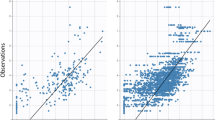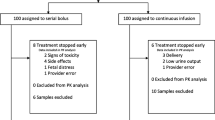Abstract
Magnesium sulfate (MgSC4) is the agent most commonly used for treatment of eclampsia and prophylaxis of eclampsia in patients with severe pre-eclampsia. It is usually given by either the intramuscular or intravenous routes. The intramuscular regimen is most commonly a 4g intravenous loading dose, immediately followed by 10g intramuscularly and then by 5g intramuscularly every 4 hours in alternating buttocks. The intravenous regimen is given as a 4g dose, followed by a maintenance infusion of 1 to 2 g/h by controlled infusion pump.
After administration, about 40% of plasma magnesium is protein bound. The unbound magnesium ion diffuses into the extravascular-extracellular space, into bone, and across the placenta and fetal membranes and into the fetus and amniotic fluid. In pregnant women, apparent volumes of distribution usually reach constant values between the third and fourth hours after administration, and range from 0.250 to 0.442 L/kg. Magnesium is almost exclusively excreted in the urine, with 90% of the dose excreted during the first 24 hours after an intravenous infusion of MgSO4. The pharmacokinetic profile of MgSO4 after intravenous administration can be described by a 2-compartment model with a rapid distribution (α) phase, followed by a relative slow β phase of elimination.
The clinical effect and toxicity of MgSO4 can be linked to its concentration in plasma. A concentration of 1.8 to 3.0 mmol/L has been suggested for treatment of eclamptic convulsions. The actual magnesium dose and concentration needed for prophylaxis has never been estimated. Maternal toxicity is rare when MgSO4is carefully administered and monitored. The first warning of impending toxicity in the mother is loss of the patellar reflex at plasma concentrations between 3.5 and 5 mmol/L. Respiratory paralysis occurs at 5 to 6.5 mmol/L. Cardiac conduction is altered at greater than 7.5 mmol/L, and cardiac arrest can be expected when concentrations of magnesium exceed 12.5 mmol/L. Careful attention to the monitoring guidelines can prevent toxicity. Deep tendon reflexes, respiratory rate, urine output and serum concentrations are the most commonly followed variables.
In this review, we will outline the currently available knowledge of the pharmacokinetics of MgSO4 and its clinical usage for women with pre-eclampsia and eclampsia.

Similar content being viewed by others
References
Pritchard JA. Management of pre-eclampsia and eclampsia. Kidney Int 1980; 18: 259–66
Saftlas AF, Olson DR, Franks AL, et al. Epidemiology of preeclampsia and eclampsia in the United States, 1979–1986. Am J Obstet Gynecol 1990; 163: 460–5
Rosenfield A, Maine D. Maternal mortality — a neglected tragedy. Where is the M in MCH? Lancet 1985; II (8446): 83–5
Duley L. Maternal mortality associated with hypertensive disorders of pregnancy in Africa, Asia, Latin America and Caribbean. Br J Obstet Gynaecol 1992; 99: 547–53
Redman CWG, Jefferies M. Revised definition of pre-eclampsia. Lancet; 1988: 1: 809–12
Australasian Society for the Study of Hypertension in Pregnancy. Consensus statement: management of hypertension in pregnancy: executive summary. Med J Aust 1993; 158: 700–2
Brown MA, Buddie ML. What’s in a name? Problems with the classification of hypertension in pregnancy. J Hypertens 1997; 15: 1049–54
Lazard EM. Apreliminary report on the intravenous use of magnesium sulphate in puerperal eclampsia. Am J Obstet Gynecol 1925; 9: 178–88
The Eclampsia Trial Collaborative Group. Which anticonvulsant for women with eclampsia? Evidence from the collaborative eclampsia trial. Lancet 1995; 345: 1455–63
Lucas MJ, Leveno KJ, Cunningham FG. A comparison of magnesium sulfate with phenytoin for the prevention of eclampsia. N Engl J Med 1995; 333: 201–5
Coetzee EJ, Dommisse J, Anthony J. A randomised controlled trial of intravenous magnesium sulphate versus placebo in the management of women with pre-eclampsia. Br J Obstet Gynaecol 1998; 105: 300–3
Sibai BM. Management of preeclampsia. Clin Perinatol 1991; 18: 793–808
Duley L, Neilson JP. Magnesium sulphate and pre-eclampsia. Trial needed to see whether it’s as valuable in pre-eclampsia as in eclampsia. BMJ 1999; 319: 3–4
Sibai BM, Spinnato JA, Watson DL, et al. Effect of magnesium sulfate on electroencephalographic findings in pre-eclampsia-eclampsia. Obstet Gynecol 1984; 64: 261–6
Del Castillo J, Engbaek L. The nature of neuromuscular block produced by magnesium. J Physiol 1954; 124: 370–3
Idama TO, Lindow SW Magnesium sulphate: areview of clinical pharmacology applied to obstetrics. Br J Obstet Gynecol 1998; 105: 260–8
Villar MA, Sibai BM. Eclampsia. Obstet Gynecol Clin North Am 1988; 15: 355–77
Friedman SA. Pre-eclampsia: areview oftheroleofprostaglandins. Obstet Gynecol 1988; 71: 122–37
Watson KV, Moldow CF, Ogburn PL, et al. Magnesium sulfate: rationale for its use in pre-eclampsia. Proc Natl Acad Sci USA 1986; 83: 1075–8
Sipes LS, Weiner CP, Gellhaus TM, et al. Effect of magnesium sulphate infusion upon plasma prostaglandins in pre eclamptic and pre term labour. Hypertens Preg 1994; 13: 293–302
Belfort MA, Moise Jr KJ. Effect of magnesium sulfate on maternal brain blood flow in pre-eclampsia: a randomized, placebo-controlled study. Am J Obstet Gynecol 1992; 167: 661–6
Naidu S, Payne AJ, Moodley J, et al. Randomized study assessing the effect of phenytoin and magnesium sulphate on maternal cerebral circulation in eclampsia using transcranial Doppler ultrasound. Br J Obstet Gynaecol 1996; 103: 111–6
Watkins JC, Evans RH. Excitatory amino acids transmitters. Annu Rev Pharmacol Toxicol 1981; 21: 165–204
Watkins JC. Excitatory amino acids and central synaptic transmission. Trends Pharmacol 1984; 5: 373–76
Cotton DB, Hallak M, Janusz C, et al. Central anticonvulsant effects of magnesium sulphate on N-methyl-D-aspartate-induced seizures. Am J Obstet Gynecol 1993; 168: 974–8
Cotton DB, Janusz CA, Berman R. Anticonvulsant effects of magnesium sulphate on hippocampal seizures. Therapeutic implications in pre eclampsia-eclampsia. Am J Obstet Gynecol 1992; 166: 1127–36
Sibai BM, Lipshitz J, Anderson GD, et al. Reassessment of intravenous MgSO4 therapy in pre-eclampsia-eclampsia. Obstet Gynecol 1981; 57: 199–201
Pritchard JA. The use of magnesium ion in the management of eclamptogenic toxemias. Surg Gynecol Obstet 1955; 100: 131–40
Flowers CE, Eastetrics WE, White FD, et al. Magnesium sulfate in toxemia of pregnancy. Obstet Gynecol 1962; 19: 315–27
Chesley LC, Tepper I. Plasma levels of magnesium attained in magnesium sulfate therapy for pre-eclampsia and eclampsia. Surg Clin North Am 1957; 37: 353–67
Chesley LC, Tepper I. Some effects of magnesium loading upon renal excretion of magnesium and certain other electrolytes. J Clin Invest 1958; 37: 1362–72
Handwerker SM, Altura BT, Chi DS, et al. Serum ionized magnesium levels during intravenous MgSO4 therapy of preeclamptic women. Acta Obstet Gynecol Scand 1995; 74: 517–9
Chesley LC. Parenteral magnesium sulfate and the distribution, plasma levels, and excretion of magnesium. Am J Obstet Gynecol 1979; 133: 1–7
Peiker G, Muller B, Erdmanm M, et al. The pharmacokinetics of magnesium sulfate in pregnant women with threatened abortion and fetal retardation. Pharmazie 1987; 42: 531–2
Wang YL, Chen G. Pharmacodynamic modeling of cardiovascular effects of magnesium in pregnancy induced hypertensive gravidas. Chin J Clin Pharmacol 1994; 10 (2): 87–92.
Flowers CE. Magnesium sulfate in obstetrics. A study of magnesium in plasma, urine, and muscle. Am J Obstet Gynecol 1965; 91: 763–5
Hall DG. Serum magnesium in pregnancy. Obstet Gynecol 1957; 9 (2): 158–66.
Brandt LJ, Glaser W, Jones A. Soft tissue distribution and plasma disappearance of intravenously administered isotopic magnesium with observations on uptake in bone. Metabolism 1958; 7: 355–61
Fong J, Gurewitsch ED, Volpe L, et al. Baseline serum and cerebrospinal fluid magnesium levels in normal pregnancy and pre-eclampsia. Obstet Gynecol 1995; 85 (3): 444–8.
Thurnau GR, Kemp DB, Jarvis A. Cerebrospinal fluid levels of magnesium in patients with pre-eclampsia after treatment with intravenous magnesium sulfate: a preliminary report. Am J Obstet Gynecol 1987; 157: 1435–8
Oppelt WW, Macintyre I, Rail DP. Magnesium exchange between blood and cerebrospinal fluid. Am JPhysiol 1963; 205: 959–62
Aikawa J, Bruns PD. Placental transfer and fetal tissue uptake of Mg2+in the rabbit. Proc Soc Exp Biol Med 1960; 105: 957–9
Mcguinness GA, Weinstein MM, Cruikshank DP, et al. Effect of magnesium sulfate treatment on perinatal calcium metabolism. II: neonatal responses. Obstet Gynecol 1980; 56: 595–600
Cruikshank DP, Varner MW, Pitkin RM. Breast milk magnesium and calcium concentrations following magnesium sulfate treatment. Am J Obstet Gynecol 1982; 143: 685–8
Cruikshank DP, Pitkin RM, Donnelly E, et al. Urinary magnesium, calcium, and phosphate excretion during magnesium sulfate infusion. Obstet Gynecol 1981; 58: 430–4
Chen G, Li QN, Guo N. Studies on the pharmacokinetics and pharmacodynamics of MgSO4 in the treatment of pregnancyinduced hypertension. Chin J Clin Pharmacol 1991; 7 (2): 108–11.
Carney SL. Effect of magnesium deficiency on renal magnesium. J Clin Invest 1980; 65: 180–8
Cruikshank DP, Pitkin RM, Reynolds WA, et al. Effects of magnesium sulfate treatment on perinatal calcium metabolism. I: maternal and fetal responses. Am J Obstet Gynecol 1979; 134: 243–9
Petrie RH. Tocolysis using magnesium sulfate. Semin Perinatal 1981; 5: 266–73
Perticone F, Adinolfi L, Bonaduce D. Efficacy of magnesium sulfate in the treatment of torsade de pointes. Am Heart J 1986; 112: 847–9
Morris ME, LeRoy S, Sutton SC. Absorption of magnesium from orally administered magnesium sulfate in man. Clin Toxicol 1987; 25: 371–82
Zuspan FP Treatment of severe pre-eclampsia and eclampsia. Clin Obstet Gynecol 1966; 9: 945–72
Pritchard JA. The use of magnesium sulfate in pre-eclampsiaeclampsia. J Reproduct Med 1979; 23: 107–14
Sibai BM, Graham JM, McCubbin JH. A comparison of intravenous and intramuscular magnesium sulfate regimens in preeclampsia. Am J Obstet Gynecol 1984; 150: 728–33
Sibai BM. Magnesium sulphate is the ideal anticonvulsant in pre-eclampsia-eclampsia. Am J Obstet Gynecol 1990; 162: 1141–5
Winkler AW, Smith PK, Hoff HE. Intravenous magnesium sulphate in the treatment of nephritic convulsions in adults. J Clin Invest 1942; 21: 207–16
McCubbin JH, Sibai BM, Abdella TN, et al. Cardiorespiratory arrest due to acute maternal hypermagnesaemia. Lancet 1981; I (8228): 1058.
Monif GRG, Savory J. Iatrogenic maternal hypocalcaemia following magnesium sulphate therapy. JAMA 1972; 219: 1469–70
Eisenbud E, Lobue CC. Hypocalcaemia after therapeutic use of magnesium sulphate. Arch Intern Med 1976; 136: 688–91
Lipsitz PJ, English IC. Hypermagnesemia in the newborn infant. Pediatrics 1967; 40: 856–62
Stone SR, Pritchard JA. Effect of maternally administered magnesium sulfate in the neonate. Obstet Gynecol 1970; 35: 574–7
Nelson KB, Grether JK. Can magnesium sulfate reduce the risk of cerebral palsy in very low birthweight infants? Pediatrics 1995; 95: 263–9
Schendel DE, Berg CJ, Yeargin-Allsopp M, et al. Prenatal magnesium sulfate exposure and the risk for cerebral palsy or mental retardation among very low-birth-weight children aged 3 to 5 years. JAMA 1996; 276: 1805–11
Paneth N, Jetton J, Pintomartin J, et al. Magnesium sulfate in labor and risk of neonatal brain lesions and cerebral palsy in low birthweight infants. Pediatrics 1997; 99: Ell–6
Mittendorf R, Covert R, Boman J, et al. Is tocolytic magnesium sulphate associated with increased total paediatric mortality? Lancet 1997; 350: 1517–8
Ghoneim MM, Long JP The interaction between magnesium and other neuromuscular blocking agents. Anesthesiology 1970; 32: 23–7
Baraka A, Yazigi A. Neuromuscular interaction of magnesium with succinylcholine-vecuronium sequence in the eclamptic parturient. Anesthesiology 1987; 67: 806–8
Vincent RD, Chestnut DH, Sipes SL, etal. Magnesium sulphate decreases maternal blood pressure but not uterine blood flow during epidural anaesthesia in gravid ewes. Anesthesiology 1991; 74: 77–82
Lin CC, Pielet BW, Poon E, et al. Effect of magnesium sulphate on fetal heart rate variability in pre eclamptic patients during labour. Am J Perinatal 1988; 5: 208–13
Fenakel K, Fenakel G, Appleman Z, et al. Nifedipine in the treatment of severe pre-eclampsia. Obstet Gynecol 1991; 77: 331–7
Acknowledgements
The authors would like to thank Xiaomei Cao and Jinqiu Xu for their assistance in preparing the manuscript, and Dr Cyprian O. Onyeji for his review.
Author information
Authors and Affiliations
Corresponding author
Rights and permissions
About this article
Cite this article
Lu, J.F., Nightingale, C.H. Magnesium Sulfate in Eclampsia and Pre-Eclampsia. Clin Pharmacokinet 38, 305–314 (2000). https://doi.org/10.2165/00003088-200038040-00002
Published:
Issue Date:
DOI: https://doi.org/10.2165/00003088-200038040-00002




